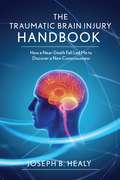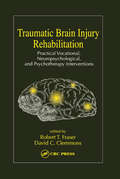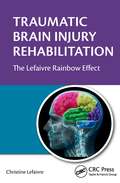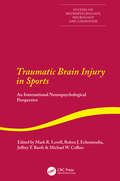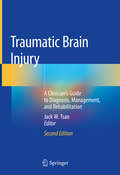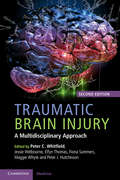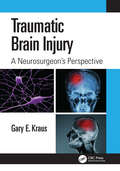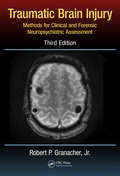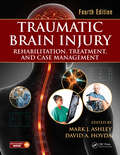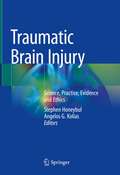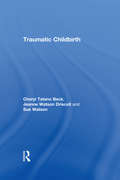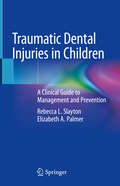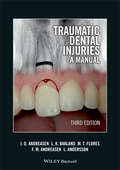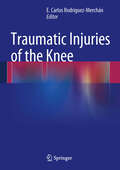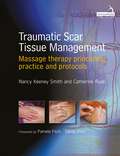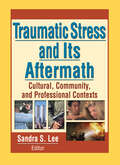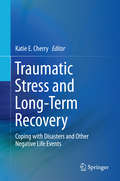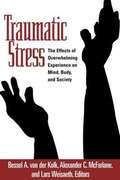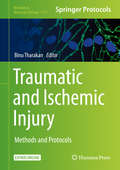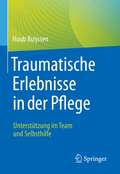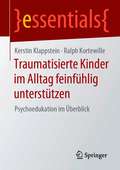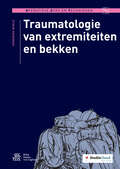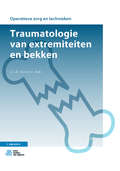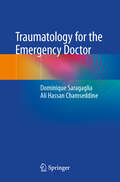- Table View
- List View
Traumatic Brain Injury Handbook: How a Near-Death Fall Led Me to Discover a New Consciousness
by Joseph HealyNew Consciousness is the ultimate brain injury recovery handbook. Inside, acclaimed writer Joe Healy comprehensively discusses what leads to brain injuries and how to heal from them and manage them during the process. Recovery techniques are lifestyle modifications: nutritional, physical, occupational, and attitude ones. This is an important title for all family and friends of sufferers of brain injuries, doctors, and caretakers. With Healy's guidance, support networks will learn how to lead sufferers on their journey back to "normalcy," working and socializing as the person did before the traumatic event. This unique book is distinctive in its scope, covering the science of the brain, its easy-to-follow nature, its accuracy, and its encouraging you-can-recover, don't just learn to cope and give up attitude. Family, friends of the injured person no longer need to feel alone, discouraged, or overwhelmed. This is a much-needed, hands-on, and extremely valuable volume.
Traumatic Brain Injury Rehabilitation: Practical Vocational, Neuropsychological, and Psychotherapy Interventions
by Robert T. Fraser David C. ClemmonsAddressing the critical issues in community re-entry in a very practical manner, this book is suitable for all members of a community re-entry or brain-injury rehabilitation team. Traumatic Brain Injury Rehabilitation: Practical Vocational, Neuropsychological, and Psychotherapy Interventions provides innovative guidelines for allied health members of the traumatic brain injury rehabilitation team with information to help achieve more successful vocational and psychosocial outcomes. The book provides a very clear overview of critical components of neuropsychological information and the use of this information in vocational planning; examples of functional areas of cognition and neuropsychological assessment; the linkages between cognitive and behavioral impairments; the different categories of assistive technology; psychotherapy and behavioral interventions as well as successful vocational interventions; and, models of work access, including methods of supported employment, the development of a tailored job coaching program, and the specifics of utilizing natural supports. This book is useful to anyone involved in neurorehabilitation, vocational rehabilitation, rehab psychology, neuropsychology, and students in counseling programs or studying medical aspects of disability.
Traumatic Brain Injury Rehabilitation: The Lefaivre Rainbow Effect
by Christine LefaivreThe Lefaivre Rainbow Effect is a groundbreaking treatment for those suffering from a traumatic brain injury (TBI). This strategy is different from most others because it is individually designed for each client and focuses on the cognitive retraining of the brain based on pre-injury lifestyle as well as the organic damage to the brain, rather than
Traumatic Brain Injury in Sports
by Michael Collins Mark Lovell Jeffrey Barth Ruben EchemendiaTraumatic brain injury (TBI) in sports has become an important international public health issue over the past two decades. However, until recently, return to play decisions following a sports-related traumatic brain injury have been based on anecdotal evidence and have not been based on scientifically validated clinical protocols. Over the past decade, the field of Neuropsychology has become an increasingly important component of the return to play decision making process following TBI. Neuropsychological assessment instruments are increasingly being adapted for use with athletes throughout the world and the field of sports neuropsychology appears to be a rapidly evolving subspecialty. This book provides a comprehensive overview of the application of neuropsychological assessment instruments in sports, and it is structured to present a global perspective on contemporary research. In addition to a review of current research, Traumatic Brain Injury in Sports: An International Neuropsychological Perspective, presents a thorough review of current clinical models that are being implemented internationally within American and Australian rules football, soccer, boxing, ice hockey, rugby and equestrian sports.
Traumatic Brain Injury: A Clinician’s Guide to Diagnosis, Management, and Rehabilitation
by Jack W. TsaoThis thoroughly revised and updated work covers numerous advances in traumatic brain injury diagnosis, evaluation, treatment, and pathophysiology. Since publication of the first edition in 2012, there has been greatly increased public awareness of the clinical consequences of even the mildest of head injuries, and the result has been a concerted effort of countries around the world to increase research funding. This second edition continues to focus on mild traumatic brain injury--or concussion--and contains updates to all the original chapters as well as adding new chapters addressing clinical sequelae, including pediatric concussion, visual changes, chronic traumatic encephalopathy, and blast-associated TBI. Traumatic Brain Injury: A Clinician's Guide to Diagnosis, Management, and Rehabilitation, Second Edition, is a comprehensive resource designed for neurologists, primary care clinicians, sports physicians, and other medical providers, including psychologists and neuropsychologists, as well as athletic trainers who may evaluate and care for individuals who have sustained a TBI. The book features summaries of the most pertinent areas of diagnosis and therapy, which can be readily accessed by the busy clinician/professional. In addition, the book's treatment algorithms provide a highly practical reference to cutting edge therapies, and an updated appendix of ICD codes is included. An outstanding contribution to the literature, Traumatic Brain Injury: A Clinician's Guide to Diagnosis, Management, and Rehabilitation, Second Edition, again offers an invaluable resource for all providers who treat patients with TBI.
Traumatic Brain Injury: A Multidisciplinary Approach
by Peter C. Whitfield Jessie Welbourne Elfyn Thomas Fiona Summers Maggie Whyte Peter J. HutchinsonAdvocating a pragmatic and multidisciplinary approach to the management of patients with brain injuries, Traumatic Brain Injury provides a detailed description of care along the whole-patient pathway. Delivering an evidence-based update on the optimal care of both adult and paediatric patients who have sustained injuries ranging from mild to severe, information from on-going multi-centre studies in neurotrauma is included. The basic scientific principles of neuropathology, head injury research and scoring systems are presented before detailed sections on emergency department care, patient transfer, intensive care and longer-term care. Rehabilitation is reviewed in detail with chapters discussing the aims and roles of physiotherapy, occupational therapy and neuropsychology amongst others. Discussing medico-legal issues in detail, the effect of injury on the individual and their family are also examined. Emphasising a holistic approach to caring for patients with brain injuries, this is an essential guide for all involved.
Traumatic Brain Injury: A Neurosurgeon's Perspective
by Gary E. KrausThis new book from leading neurosurgeon and author Gary Kraus is an account of traumatic brain injury (TBI) from the time a brain-injured patient arrives in the emergency department through to the wide range of clinical outcomes of such an injury. Written with the voice of experience, the author examines causation of TBI, the patient’s stay in the neuro-intensive care unit and the many neurological assessments and tests that inform the outcomes that the patient and their families will encounter. A wide range of medical professionals will benefit from Dr Kraus’s acute insights into TBI including Neurosurgical residents, Neurosurgeons with a sub-specialist interest in Neuro-Trauma, Neurologists managing patients with post traumatic brain injury, Neuro-Intensivists, Neuro-Psychologists, Researchers/scientists involved in Clinical trial in traumatic brain injury, and those with a specialist interest in Neuro-rehabilitation.
Traumatic Brain Injury: Methods for Clinical and Forensic Neuropsychiatric Assessment,Third Edition
by Daryl B. Lund Robert P. Granacher Jr.Traumatic Brain Injury: Methods for Clinical and Forensic Neuropsychiatric Assessment, Third Edition provides physicians and psychologists with a scientifically based schema for the clinical evaluation of traumatic brain injury (TBI). The book assists physicians and psychologists in developing treatment plans for patients who have sustained TBIs an
Traumatic Brain Injury: Rehabilitation, Treatment, and Case Management, Fourth Edition
by Mark J. Ashley David A. HovdaIn the last decade neuroscience has matured at a remarkable pace, shedding a far more exacting light on mechanisms of neurophysiology, pathophysiology of injury, neuroendocrinology, neuro-immunology, neuroplasticity, neuropharmacology and neurodegenerative processes. Individuals with acquired brain injury are treated earlier and now achieve far better recovery than in the past. The fourth edition of this text constitutes a continuation of 20 years of coverage of traumatic brain injury, and broadens the discussion of acquired brain injury. Within TBI, the paradigm shift from an injury occurring at a point in time to a disease entity of a chronic nature is changing the discussion of diagnosis, management, treatment and outcome assessment. Disease specification that differentiates TBIs by the mechanism of injury, the exact nature of the injury, the extent of injury, presence of co-morbidities and their exact nature, gender, age, race, and genome are emerging as crucial. There was a time when cancer was an undifferentiated disease. Disease differentiation has consequently impacted diagnosis, treatment and outcome. This text is intended to serve as a ready reference tool, contributing to the professional growth of each reader, and stimulating innovation and research. It also promotes the continued refinement in the management of diseases of acquired brain injury.
Traumatic Brain Injury: Science, Practice, Evidence and Ethics
by Stephen Honeybul Angelos G. KoliasThis book provides a comprehensive analysis of the contemporary management of all aspects of traumatic brain injury (TBI), combining the findings of several recent randomised controlled trials investigating the role of hypothermia, erythropoietin, intracranial pressure monitoring and decompressive craniectomy in the management of TBI. The book is divided into four sections: the first section covers the epidemiology of TBI, the changing global patterns of presentation, and the basic pathophysiology and classification, while the second discusses contemporary management of TBI, from pre-hospital care, emergency assessment, and medical and surgical management to rehabilitation and social reintegration. The third section then examines the evidence gained from recent clinical trials that have investigated the efficacy of management strategies involving intracranial pressure monitoring, multimodal monitoring, hypothermia, erythropoietin, thromboembolic prophylaxis and decompressive craniectomy. Lastly, the fourth section explores the ethical issues, both at the societal level and on an individual basis. Written by a broad range of experts, this book provides a valuable reference resource for neurosurgeons, intensivists, clinicians with ethical experience and pure bioethicists in their daily work.
Traumatic Brain and Spinal Cord Injury
by Cristina Morganti-Kossmann Ramesh Raghupathi Andrew MaasTraumatic Brain and Spinal Cord Injury comprehensively covers the medical and pathological issues related to neurotrauma and its often devastating consequences. Written by globally renowned experts in the field, both clinicians and researchers will find this book invaluable to update their knowledge. This volume is divided into two sections, one covering the brain, the other the spinal cord. Each section discusses the following topics: The demographic in the developed and developing world where neurotrauma is witnessing a massive expansion Major clinical issues including advanced semi-experimental monitoring techniques utilized by neurosurgeons and intensivists and the potential use of identifying markers of tissue injury Overview of major pathophysiological changes The development of animal models; successes and limitations Past, current and future therapeutic strategies including rehabilitative opportunities. Presenting the most up-to-date clinical and experimental research in neurotrauma, this volume is essential reading for neurologists, neurosurgeons, intensive care physicians and rehabilitative physicians.
Traumatic Childbirth
by Jeanne Watson Driscoll Cheryl Tatano Beck Sue WatsonPostpartum depression has become a more recognized mental illness over the past decade as a result of education and increased awareness. Traumatic childbirth, however, is still often overlooked, resulting in a scarcity of information for health professionals. This is in spite of up to 34% of new mothers reporting experiencing a traumatic childbirth and prevalence rates rising for high risk mothers, such as those who experience stillbirth or who had very low birth weight infants. This ground-breaking book brings together an academic, a clinician and a birth trauma activist. Each chapter discusses current research, women’s stories, the common themes in the stories and the implications of these for practice, clinical case studies and a clinician’s insights and recommendations for care. Topics covered include: mothers’ perspectives, fathers’ perspectives, the impact on breastfeeding, the impact on subsequent births, PTSD after childbirth and EMDR treatment for PTSD. This book is a valuable resource for health professionals who come into contact with new mothers, providing the most current and accurate information on traumatic childbirth. It also presents mothers’ experiences in a manner that is accessible to women, their partners, and families.
Traumatic Dental Injuries in Children: A Clinical Guide to Management and Prevention
by Rebecca L. Slayton Elizabeth A. PalmerThis book is a clinical guide to the prevention and management of traumatic dental injuries, including crown and root fractures and luxation injuries, in children of all ages. Readers will find clear descriptions of the challenges posed by the pediatric population, the evaluation of injuries, diagnosis, management, and follow-up. Whenever available, evidence-based guidelines are used to inform clinicians of the most appropriate care for each type of injury. A holistic approach is adopted, taking into account the child's developmental stage and ability to tolerate the proposed treatment. When indicated, more advanced forms of behavior guidance are discussed to enable the delivery of safe and effective care that will allow the best outcome to be achieved. Often, traumatic dental injuries result in sequelae that compromise the health of the developing permanent teeth. These sequelae and appropriate treatment options are described along with innovative approaches designed to preserve bone and maximize future treatment possibilities. The book will be a valuable asset for both pediatric and general dentists.
Traumatic Dental Injuries: A Manual
by Frances M. Andreasen Leif K. Bakland Jens O. Andreasen Maria Teresa Flores Lars AnderssonThe third edition of Traumatic Dental Injuries: A Manual builds on the widespread success of the previous two editions. The ultimate guide to dental trauma, the manual preserves its uniquely usable and reader-friendly format, demonstrating step-by-step treatment protocols for commonly occurring traumatic injuries. Several new sections have been added to expand the number of clinical scenarios, describing soft tissue injuries associated with dental trauma, showing how decoronation of ankylosed anterior teeth in adolescents can preserve the alveolar process for later implant placement, and identifying predictors for pulpal and periodontal ligament healing complications as well as for tooth loss. A unique feature of the new edition is the accompanying DVD which presents computer animations of all trauma scenarios, as well as links to the internet-based interactive Dental Trauma Guide to predict healing complication for individual trauma scenarios. This title is also available as a mobile App from MedHand Mobile Libraries. Buy it now from Google Play or the MedHand Store. Please noteThe DVD no longer accompanies the book but all of the DVD's content can be accessed via the following link:https://wiley.mpstechnologies.com/wiley/BOBContent/searchLPBobContent.do Once here, please enter the ISBN and click 'search'. The content will then be available to download.
Traumatic Injuries of the Knee
by E. Carlos Rodrìguez-MerchánThis book reviews the most important traumatic injuries that occur around the knee joint, providing detailed information on mechanisms of injury, diagnosis, and treatment. A wide range of injuries are covered, including jumper's knee, meniscus tears, knee ligament injuries, knee extensor mechanism injuries, and the floating knee. Dislocations of the knee and patella are carefully considered. Osteochondral fractures and fractures of the distal femur and tibial plateau are discussed in individual chapters that provide clear guidance on treatment. The book closes by reviewing the management of malunion and non-union about the knee. The authors are acknowledged experts in the field and have taken care to ensure that all information is completely up to date. This well-illustrated and instructive book will be of value to orthopedic surgeons, sports medicine specialists, and others who work with patients with traumatic knee injuries.
Traumatic Scar Tissue Management: Principles and Practice for Manual Therapy
by Catherine Ryan Nancy Keeney SmithThe management of scar tissue is a huge and growing problem for massage and other manual therapists. Research has showed that appropriate massage treatment can have significant results both physically and psychologically. Existing books have chapters on the problem but there is no practical manual available on the subject at the present time which tells the therapist what to do (and what not to do). This book fills that gap, explaining the physiologic and pathophysiologic background, and providing practical guidance about how to help patients.
Traumatic Stress and Its Aftermath: Cultural, Community, and Professional Contexts
by Sandra LeeExplore the aftermath of traumatic stress as it affects various populations, including therapists themselves! This book will educate you about the aftermath of traumatic stress as it impacts people in a variety of settings. It explores the factors that lead to increased or reduced vulnerability to the effects of traumatic stress, emphasizing the impact of cumulative/multiple trauma rather than the effects of a single traumatic incident, to help you design and implement effective prevention and intervention programs. The specific populations and groups addressed in this important book include: adolescent girls involved in armed conflict in Colombia&’s guerilla war urban African-American youth-a theoretical model for risk and resiliency people with strong spiritual/religious beliefs-how spirituality can affect a person&’s reaction to traumatic stress women in recovery in a community aftercare shelter female trauma therapists-factors affecting vicarious traumatization of helping professionals college students with histories of abuse Providing a framework for understanding traumatic stress-related issues based on a variety of methodologies and measures, Traumatic Stress and Its Aftermath addresses important questions, such as: What is the relationship between the experiences of trauma or other stressful life events, and subsequent traumatic stress? What are the protective factors that can buffer or ameliorate the development of traumatic stress in the face of adverse life experiences, trauma, or other stressful events? How do these questions evolve in different cultural or community contexts, and with different populations? What are the implications for interventions for community institutions and mental health workers? What roles do self-esteem and spirituality play in a person&’s reaction to traumatic stress? How do reactions to traumatic stress differ between women who have been sexually abused as children and women who have not? From editor Sandra S. Lee: "Contemporary developments in the study of traumatic stress are shifting. This book reflects an emphasis on the study of traumatic stress in normal community, cultural, or college student populations and groups, while other literature has focused on individuals specifically diagnosed with PTSD. In addition, Traumatic Stress and Its Aftermath: Cultural, Community, and Professional Contexts emphasizes the search for risk and protective factors and factors that can buffer the relationship between trauma exposure and subsequent distress."
Traumatic Stress and Long-Term Recovery
by Katie E. CherryThis evidence-rich collection takes on the broad diversity of traumatic stress, in both its causes and outcomes, as well as the wide variety of resources available for recovery. Its accessible coverage shows varied presentations of post-traumatic stress affected by individual, family, and group contexts, including age, previous trauma exposure, and presence or lack of social resources, as well as long-term psychological, physical, and social consequences. Contributors focus on a range of traumatic experiences, from environmental disasters (wildfires, Hurricane Katrina) to the Holocaust, from ambiguous loss to war captivity. And the book's final section, "Healing after Trauma," spotlights resilience, forgiveness, religion, and spirituality, using concepts from positive psychology. Included among the topics: The Great East Japan earthquake: tsunami and nuclear disaster. Posttraumatic stress in the aftermath of mass shootings. Psychosocial consequences: appraisal, adaptation, and bereavement after trauma. Loss, chaos, survival and despair: the storm after the storms. Aging with trauma across the lifetime and experiencing trauma in old age. On bereavement and grief: a therapeutic approach to healing. Psychologists, social workers, researchers studying trauma and resilience, and mental health professionals across disciplines will welcome Traumatic Stress and Long-Term Recovery as a profound source of insight into stress and loss, coping and healing.
Traumatic Stress: The Effects of Overwhelming Experience on Mind, Body, and Society
by Bessel van der Kolk Alexander McfarlaneThis bestselling classic presents seminal theory and research on posttraumatic stress disorder (PTSD). Together, the leading editors and contributors comprehensively examine how trauma affects an individual's biology, conceptions of the world, and psychological functioning. Key topics include why certain people cope successfully with traumatic experiences while others do not, the neurobiological processes underlying PTSD symptomatology, enduring questions surrounding traumatic memories and dissociation, and the core components of effective interventions. A highly influential work that laid the foundation for many of the field's continuing advances, this volume remains an immensely informative and thought-provoking clinical reference and text.
Traumatic and Ischemic Injury: Methods And Protocols (Methods In Molecular Biology #1717)
by Binu TharakanThis volume focuses on procedures for the development and application of several research animal models and in vitro methods that allow researchers to gain insight into the underlying cellular, biochemical, and physiological mechanisms involved in traumatic and ischemic injury. The chapters in this book discuss topics, such as animal models and techniques commonly used to study traumatic brain injury, hemorrhagic shock, ischemic and hemorrhagic strokes, sepsis, burn injury, hind limb ischemia, myocardial-ischemia-reperfusion injury, intracranial pressure, global hypoxia-induced perinatal seizures models, and in vitro models. Written in the highly successful Methods in Molecular Biology series format, chapters include introductions to their respective topics, lists of the necessary materials and reagents, step-by-step, readily reproducible laboratory protocols, and tips on troubleshooting and avoiding known pitfalls.Cutting-edge and comprehensive, Traumatic and Ischemic Injury: Methods and Protocols is a valuable resource for novices with limited experience to help them initiate new research projects, and established researchers to help them identify comparable approaches and strategies to their studies in this field.
Traumatische Erlebnisse in der Pflege: Unterstützung im Team und Selbsthilfe
by Huub BuijssenDieses Buch richtet sich an Pflegende und zeigt, wie man traumatische Erlebnisse aus dem Berufsalltag gemeinsam im Team bewältigen kann und gibt außerdem Tipps zur Selbsthilfe. Traumatisierende Geschehnisse gehören zum Berufsrisiko von Medizin- und Gesundheitsbereich. Wie geht man persönlich mit diesen Ereignissen und Bildern um? Welchen Rückhalt findet man dann im Team? Nach einer kurzen Begriffserklärung geht der Autor auf unterschiedliche Verarbeitungsformen ein. Dabei werden emotionale Phasen ebenso dargestellt wie Störungen der Trauma-Verarbeitung.
Traumatisierte Kinder im Alltag feinfühlig unterstützen: Psychoedukation im Überblick (essentials)
by Kerstin Klappstein Ralph KortewilleDieses essential beschreibt alltagstauglich und fundiert, wie Kinder mit Bindungstraumatisierung feinfühlig begleitet werden können. Es erklärt leicht verständlich, wie sich Traumapädagogik und Traumapsychotherapie ergänzen. Gerade wenn das Kind in Krisen am dringendsten Verständnis, Orientierung und Beruhigung von seinen Bezugspersonen braucht, liegen deren Nerven oft blank. Dieses essential will Erwachsene dabei unterstützen, das Verhalten des Kindes vor dem Hintergrund dessen Biografie zu verstehen. Diese Reflexion hilft dabei, Unterstützungsangebote zwischen hilfreicher Distanz und förderlicher Empathie auszubalancieren zu können.
Traumatologie van extremiteiten en bekken
by Hendries BoeleTraumatologie van extremiteiten en bekken bestaat uit zeven delen die achtereenvolgens behandelen: de algemene principes en richtlijnen van dit specialisme, osteosynthesematerialen en diverse fracturen 'van clavicula tot teen'. Nieuw voor deze uitgave is dat ieder deel begint met een paragraaf waarin de anatomie besproken wordt van de desbetreffende extremiteit. In de laatste twee delen wordt stilgestaan bij de pathologische fracturen, de ribfracturen en fractuurbehandeling bij kinderen. Van een selectie uit de vele fractuurtypen en behandeltechnieken die in dit boek aan bod komen, is een uitgebreid operatieverslag opgenomen. Dit boek, dat in de eerste plaats is geschreven als leerboek voor de operatieassistent, heeft als doel de lezer bekend te maken met de verschillende osteosynthesetechnieken. Daarnaast is het geschikt als naslagwerk voor andere beroepsgroepen in de gezondheidszorg.De reeks 'Operatieve Zorg en Technieken' is bestemd voor de opleiding tot operatieassistent. Naast het basisboek bestaat de reeks uit een aantal vervolgdelen, waarin de verschillende subspecialismen van de chirurgie worden behandeld.Elk deel in de reeks heeft dezelfde indeling. Ieder hoofdstuk begint met een inleiding, gevolgd door een uitwerking van de pre-, per- en postoperatieve fase van de operatie. Bij alle operatiebeschrijvingen staan de operatie-indicatie en het doel van de operatie vermeld. De opstelling van het operatieteam wordt per operatiebeschrijving verduidelijkt door een afbeelding.De reeks 'Operatieve Zorg en Technieken' benadert de beroepsuitoefening van de operatieassistent zo dicht mogelijk. De talrijke voorbeelden onderbouwen deze benadering.
Traumatologie van extremiteiten en bekken (Operatieve zorg en technieken)
by Hendries BoeleDit leerboek bestaat uit zeven delen die achtereenvolgens behandelen: de algemene principes en richtlijnen van dit specialisme, osteosynthesematerialen en diverse fracturen ‘van clavicula tot teen’. Nieuw voor deze uitgave is dat oudere implantaten, zoals het DCP, zijn verdwenen en plaats hebben gemaakt voor nieuwere implantaten en alle operatieverslagen opnieuw kritisch onder de loep genomen en deels zijn herschreven. Traumatologie van extremiteiten en bekken, dat in de eerste plaats is geschreven als leerboek voor de operatieassistent, heeft als doel de lezer bekend te maken met de verschillende osteosynthesetechnieken. Daarnaast is het geschikt als naslagwerk voor andere beroepsgroepen in de gezondheidszorg.De reeks ‘Operatieve Zorg en Technieken’ is bestemd voor de opleiding tot operatieassistent. Naast hetbasisboek bestaat de reeks uit een aantal vervolgdelen, waarin de verschillende subspecialismen van dechirurgie worden behandeld.Elk deel in de reeks heeft dezelfde indeling. Ieder hoofdstuk begint met een inleiding, gevolgd door eenuitwerking van de pre-, per- en postoperatieve fase van de operatie. Bij alle operatiebeschrijvingen staande operatie-indicatie en het doel van de operatie vermeld. De opstelling van het operatieteam wordt peroperatiebeschrijving verduidelijkt door een afbeelding.
Traumatology for the Emergency Doctor
by Dominique Saragaglia Ali Hassan ChamseddineThis handy and practical book assists emergency doctors in their daily practice offering a quick reference tool to properly diagnose and manage traumatic musculoskeletal lesions. In the opening part it provides readers with basic traumatology knowledge, enabling them to have a constructive discussion with the specialist. The other sections are devoted to upper limbs, lower limbs, pediatric trauma and skull and spine trauma. Following this anatomical subdivision, the authors offer practical tips to recognize hidden injuries, minimize diagnostic errors and avoid common pitfalls. Readers will learn how to combine careful questioning with a thorough clinical examination, backed up by appropriate, high-quality complementary tests. With its handy and easy-to-read format this book is an invaluable tool for emergency doctors and orthopedic residents alike.
